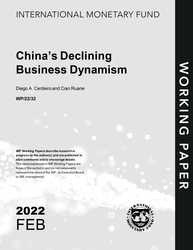
China's Declining Business Dynamism
China's Declining Business Dynamism
READ MORE...
Volume/Issue:
Volume 2022
Issue 032
Publication date: February 2022
ISBN: 9798400200359
$20.00
Add to Cart by clicking price of the language and format you'd like to purchase
Available Languages and Formats
| English |
Prices in red indicate formats that are not yet available but are forthcoming.
Topics covered in this book
This title contains information about the following subjects.
Click on a subject if you would like to see other titles with the same subjects.
Economics- Macroeconomics , Economics / General , Demography , China , total factor productivity , growth , business dynamism , , business dynamism , life-cycle growth , SOE reform , China's productivity , dynamism trend , Productivity , Public enterprises , Total factor productivity , Capital productivity , Aging
Summary
After impressive growth in the 2000s, China's productivity has more recently stagnated. We use firm-level data to analyze productivity and firm dynamism trends from 2003 to 2018. We document six facts that together show a decline in China’s business dynamism. We show that (i) the revenue share of young firms has declined, (ii) the life-cycle growth of young firms relative to older incumbents has slowed, (iii) weaker life-cycle growth can be explained by slower productivity growth and weaker investment in intangibles, (iv) younger and smaller firms are more capital constrained than their older and larger counterparts, (v) the responsiveness of capital growth to the marginal product of capital has declined, and (vi) large productivity gaps between SOEs and private firms persist. We find that business dynamism is weaker in provinces where SOEs account for a larger share of the capital stock. Our results suggest that declining private business dynamism is an important factor in explaining China's sluggish TFP growth and that SOE reform could boost productivity growth indirectly by stimulating business dynamism.
Copyright © 2010 - 2025
Powered by:
AIDC



